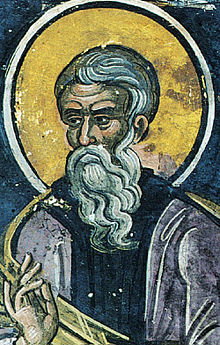Theodore of Sykeon
This article needs additional citations for verification. (January 2014) |

Saint Theodore of Sykeon was a revered Byzantine ascetic, who lived between the first half of the 6th century and the thirteenth year of the Emperor Heraclius' rule (i. e. 623)[1] in the early 7th century. His hagiography, written after 641, is a key primary source for the reign of Emperor Heraclius (r. 610–641).[2][3] His feast day is April 22.
Life[]
Early life[]
Theodore was born in Sykeon, a village in Galatia. The public highway of the imperial post ran through this village, and on the road stood an inn kept by a very beautiful girl, Mary, her mother, Elpidia, and a sister Despoinia. And these women lived in the inn and followed the profession of courtesans. Theodore was the son of Mary and Cosmas, who had become popular in the Hippodrome in the corps of those who performed acrobatic feats on camels and was appointed to carry out the Emperor's orders.[4]
When he was about twelve years old an epidemic of bubonic plague fell upon the village and it attacked him along with others so that he came near to dying. They took him to the shrine of St. John the Baptist near the village and laid him at the entrance to the sanctuary; he recovered and returned home.[4]
He used to frequent a shrine dedicated to the martyr St. George, located up the rocky hill which lay near the village. At the age of fourteen, he went there to live.[4] Even at such a young age, Theodore was granted the gift of healing.[5]
Theodore then withdrew into complete solitude, to a cave not far from the oratory of St George. He persuaded a deacon to bring him bread and water, and he told no one else where he had hidden himself.[5]
Bishop[]
For two years St Theodore lived in this seclusion until news of the youth’s exploits reached the local bishop Theodosius, who ordained him to the diaconate, and later to the holy priesthood, although the saint was only seventeen years old at the time.[5]
He was chosen Bishop of Anastasioupolis.[6]
During the reign of Emperor Maurice (r. 582–602), he foretold the emperor's death and "great tribulations, terrible scourges [that] threaten the world." He was soon proven correct with the outbreak of the 26-year-long Persian war sparked by the death of Maurice.[7] He was a close friend of the family of Emperor Phocas. Despite that, he spoke of
The trembling of the cross forecasts a crowd of misfortunes and perils for us. Yes, it forecasts fluctuations in our faith, and apostasies, invasions of many barbarian peoples, floods of blood scattered, ruin and captivity for everyone,the desolation of the holy churches, the halting of the divine service, the fall and upsetting of the Empire, embarrassments without number and serious times for the state. In short, it announces that the coming of the Enemy [devil] is soon.
— St. Theodore of Sykeon[8]
Furthermore, he would only pray for Phocas if the latter stopped massacring people. Still, after the successful rebellion of Emperor Heraclius, he intervened to save the life of Domentziolus, the nephew of Phocas. In return, St. Theodore of Sykeon was asked to "pray for [Heraclius] and his reign."[9]
St. Theodore of Sykeon had good relations with Patriarch Sergius of Constantinople.[10] Still, historian Walter Kaegi says that Heraclius "may always have felt some reserve in his relations with" St. Theodore.[11] During Lent 613, Heraclius asked for St. Theodore's blessing in fighting the Persians. St. Theodore blessed him and invited him to dinner, but Heraclius refused because of time concerns. However, the saint claimed that not accepting his gifts was a "sign of our defeat".[12] Indeed, Heraclius lost the Battle of Antioch.
He died on April 22, 613.[3]
Veneration[]
His remains were quickly brought to Constantinople to protect them from the Persian war and to add divine protection to the city. An elaborate ceremony of the reception of the remains associated St. Theodore with Heraclius's regime.[3]
Citations[]
- ^ Cf. Festugiere, A.-J., Vie de Theodore de Sykeon, t. I, Bruxelles: Societe des Bollandistes, p. V.
- ^ Kaegi 2003, pp. 9–10
- ^ Jump up to: a b c Kaegi 2003, p. 76
- ^ Jump up to: a b c Three Byzantine Saints: Contemporary Biographies of St. Daniel the Stylite, St. Theodore of Sykeon and St. John the Almsgiver, (trans. Elizabeth Dawes), (London: 1948)
- ^ Jump up to: a b c "St Theodore the Sykeote the Bishop of Anastasiopolis", Orthodox Church in America
- ^ "Our Holy Father Theodore the Sykeote", Serbian Orthodox Church
- ^ Kaegi 2003, p. 19
- ^ Kaegi 2003, p. 39
- ^ Kaegi 2003, p. 53
- ^ Kaegi 2003, p. 60
- ^ Kaegi 2003, p. 73
- ^ Kaegi 2003, pp. 75–76
References[]
- Kaegi, Walter Emil (2003), Heraclius: emperor of Byzantium, Cambridge University Press, ISBN 0-521-81459-6
External links[]
- 6th-century births
- 613 deaths
- 6th-century Byzantine bishops
- 7th-century Byzantine bishops
- 7th-century Christian saints